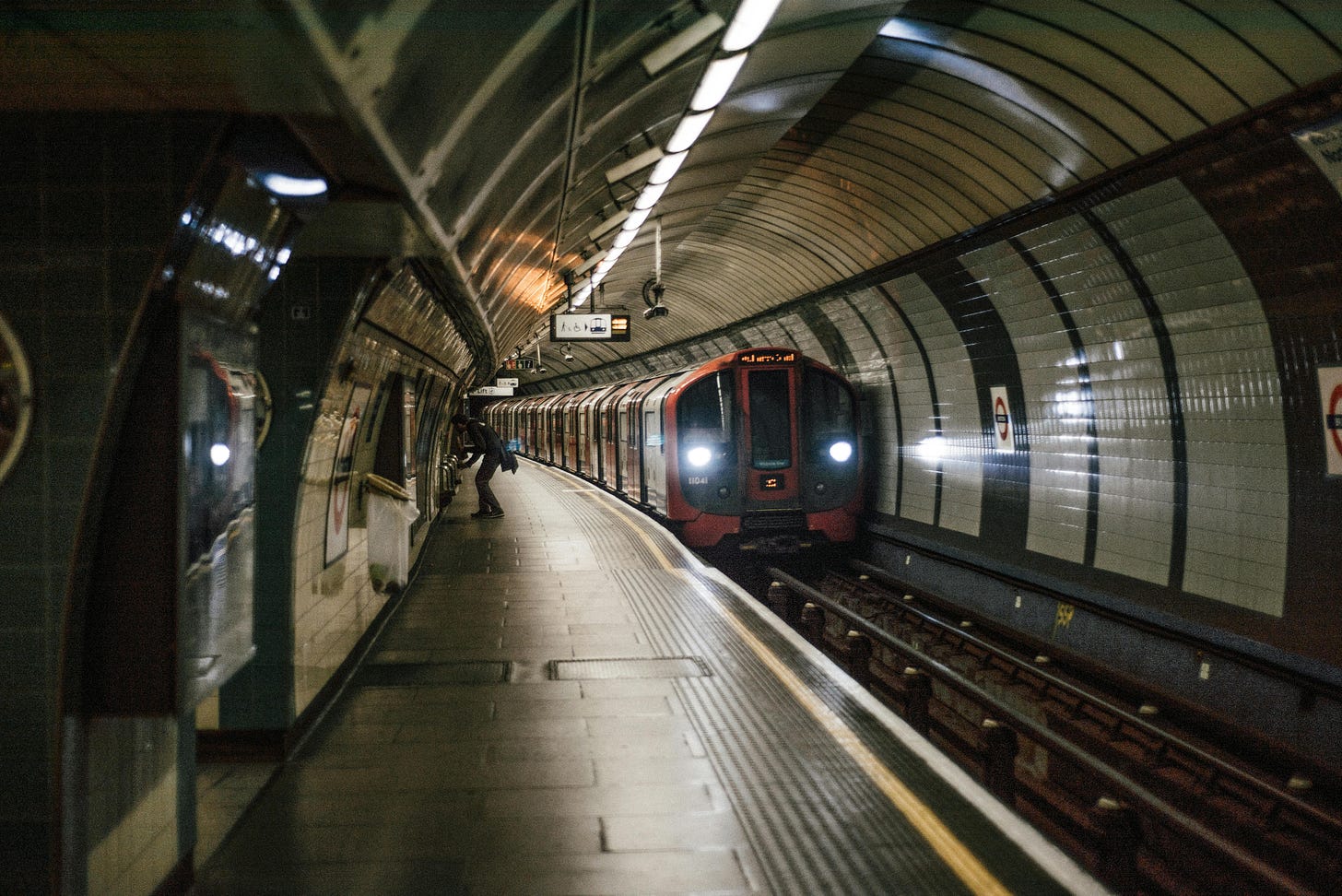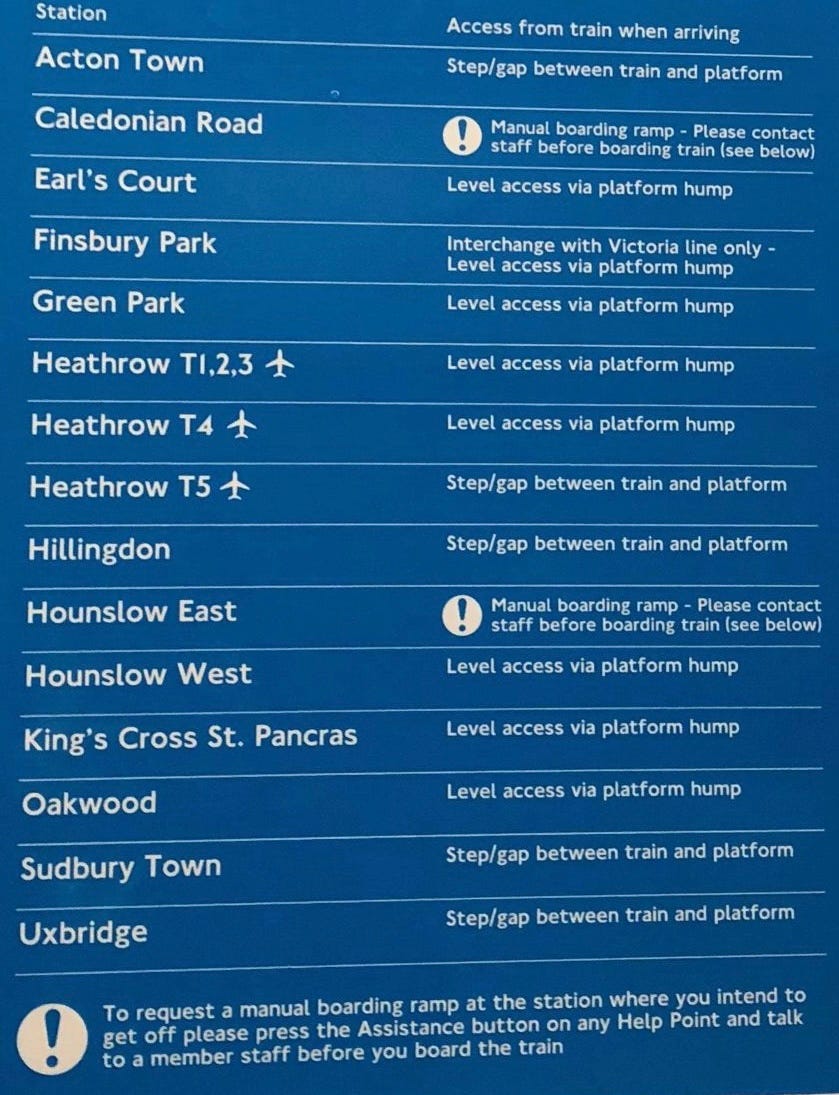The Complexity of Accessible Travel
Trapped on the Jubilee Line
You can listen to the main article in this newsletter.
Last week, I had an early hospital appointment. I’m not a morning person, so my brain is not always fully switched on before 10 am. It was quite an important appointment but everything was fine. I still pondered about what the cardiologist said and decided to go to Bond Street in Central London shopping. To get there I had to make a short underground trip from London Bridge to Bond Street station. The tube has level boarding there, and I didn’t need any assistance.
Still occupied by my thoughts, I arrived at the platform exactly when the train arrived. I boarded at the first door closest to the lift.
London transport geeks will notice my mistake immediately: It’s the wrong door for level boarding at Bond Street station. In theory, I knew that, of course. I used the Jubilee hundreds of times in my life, but I was in auto mode, not thinking about what I was doing, and London Bridge station has level boarding at every door. But not Bond Street.
When we arrived at Green Park station, another station with a platform hump (but not at my door) I realised my mistake. I was trapped. I couldn’t leave the train on my own.
Stuck in the wrong part of the train
So there I was - stuck on the Jubilee Line, checking every platform height whenever the door opened at the next station while messaging other transport geeks to find out where I could leave at the first door (if ever) before we reach Stanmore, hoping the driver would find me there and would spare me a trip to the depot. To make a long story short, Wembley station was the station of freedom, and I could leave the train by myself to travel back to Bond Street. This time, at the right door.
Don’t get me wrong, this was totally my mistake. I love platform humps and Bond Street and Green Park station and others were no-go areas for me before they had humps (and lifts). Humps mean no failed assists with boarding ramps and truly independent travel (if you’re doing it right). I prefer the humps over the manual boarding ramps any time.
Complex planning
What I wanted to highlight is the difficulties disabled people face when they are unfamiliar with stations or distracted by other thoughts. Disabled people can’t switch to idle mode when travelling. We have to be switched on at every step (or push) of the journey and ideally have the step-free tube map ready to use or saved in our mind. Rail travel can be as complex as using the tube. You have to check the accessibility of the station, the staffing level and sometimes even the rolling stock used.
I have friends who contact me to plan a tube journey for them or to check how they can travel from A to B by rail. The systems are often far too complex for the average disabled traveller, and London’s step-free tube map gets more complicated every year, ironically often because the system gets more accessible, which is good news in theory.
The complexity of navigating transport systems shows the need for accessibility information to be integrated into mainstream systems. It also needs to allow passengers to make mistakes like mine and get help.
I wonder how often wheelchair users make the same mistake as I did and board at the wrong door. Yes, the big blue stickers in the lifts explaining the platform situation at every single station are great, but it’s also a lot of text and not easy to understand for people who are not familiar with. And if you make a mistake, there must be a system to get help, more than pulling the emergency alarm, which wheelchair users often can’t even reach.
Some interesting links
Tanni Grey-Thompson went to Liverpool and experienced a pretty hassle-free journey thanks the level boarding of Merseyrail.
Nearly 250 people fell into the gap between Tube trains and the platform in London just last year, with Baker Street station coming out on top for the most accidents recorded.
Paralympian Jessica Smith about “The Harsh Truth About Disability Inclusion” for TIME Magazine.
Something to watch
Jennifer Zhang explores the psychological barriers to embracing accessibility, emphasising the need for integrated processes, personal buy-in, and change management to foster inclusive design and reduce burnout.
Some final words
The Accessible Link is a reader-supported publication. So, if you like what you’re reading, consider to
As a paid subscriber you will receive an additional edition every two weeks with best-practice tips on improving accessibility in your organisation.
Who is writing this newsletter?
I’m Christiane Link, and I improve the customer experience in aviation, transport, and travel. I worked as a journalist for over two decades and travelled extensively for business and leisure. I’m a wheelchair user.
Work with me
Whether you're a Customer service director, a Head of Customer Experience, a corporate Accessibility manager, a DEI leader, a transport planner, or a disabled employee resource group member, I can help you to make your organisation more inclusive. You can book me for speaking engagements or hire me as a consultant for your accessibility or DEI strategy, communications advice and other related matters. I have worked for airlines, airports, train operators, public transport providers, and companies in other sectors.
If you want to read more from me, follow me on LinkedIn, Twitter, Bluesky or Mastodon. You can also reply to this email if you want to contact me.
.




